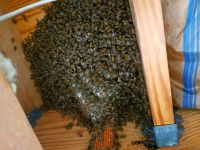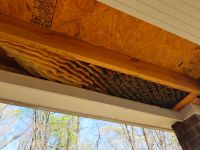Are you wondering wether you need an expert to remove a bee infestation or if you can tackle it yourself? Here are some things to keep in mind. Your are likely dealing with any where from 10,000-60,000 (or more) bees depending on the size and age of the hive. Removing honey bees from a structure is labor intensive, requires a good deal of knowledge, and can result in many stings if not done properly.
A one week old hive containing 20,000 bees.
The following methods do not work well for getting rid of honey bees.
1. Using soap and water and other “deterrents” to get the bees to leave. These do little to get honey bees to move from any location they have chosen as home. Even if you have only noticed the bees for a day it is unlikely you will get them to budge.
2. Spraying 3 or more cans of wasp or bee killer at the entry point. Spraying the entry point may kill a few hundred bees, but the bulk of the nest (up to 60,000 bees or more) is inside, behind insulation and walls and floor boards. The pesticide will unlikely penetrate far enough back to do anything to the bees. Even if you were successful at killing all the bees, there could be substantial honey comb and bee larva in the nest that will make a mess unless it is removed.
3. Seal the bees' entry point. All this does is keep the bees from coming and going freely. You wont sees bees on the outside but the bees are still alive and probably have plenty of food and air to live a long time. The bees will begin looking for other ways to get back out. Many times they will start coming in the home. We have seen bees come in a home for more than 8 weeks straight after their entry point was sealed shut.
A colony containing 30,000 honey bees and 50 plus pounds of honey.
4. Try to smoke the bees out. I have seen this tried and it failed. Smoking bees is great for beekeepers working in the own hives in the backyard. However, if you smoke bees in a house, it usually drives them further into the house. Another problem with trying to smoke the bees out of a house is that it can be dangerous. You don't want your house to catch on fire. I have seen a burned up shrub that was against a house, burned up from someone trying to smoke the bees out that were in an overhang above it.
5. Kill the bees, remove the honey comb, and repair the access area. Mission accomplished, right? Not necessarily. Unless the area is sealed properly, the pheromones left by the first hive will attract other colonies in the future. It is very likely bees will keep coming back. On one house the bees came back to the same spot three times in a matter of 5 years. The last time the home owners decided to call Southeast Bee Removal instead of doing it themselves. By the way, Southeast Bee Removal does live honey bee removal and relcoation with their removals and recommends trying to save the bees as a first choice. In most cases the bees can be saved.
6. Wait and see if the problem goes away on its own. I am an experienced beekeeper and I love bees, but I would not want them in my house. I have seen all the problems and damage they can cause if left alone. There is a possibility that someone would get stung. Also, the older a bee hive is the bigger and more difficult it will be to remove. Furthermore, the colony of bees will likely swarm in the spring (half the hive leaves and moves to a new location), and you risk having them moving into a second spot on your home or into your neighbors home.
These are some of the biggest no nos you want to avoid when considering what to do with a honey bee colony that has taken up residence in your home or business.
If you need advice/help in removing a honey bee colony you can contact Southeast Bee Removal for a free estiamte. We have lots of experience (we have removed 1,000s of bee hives) and love our job!



